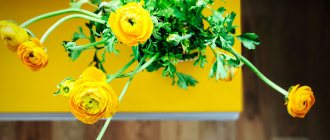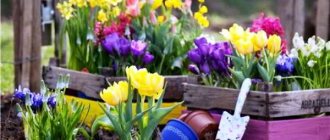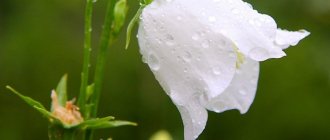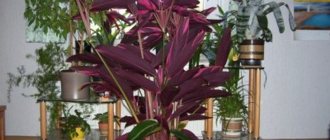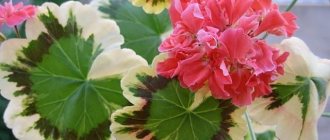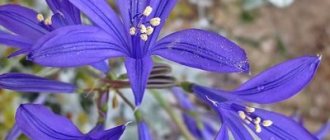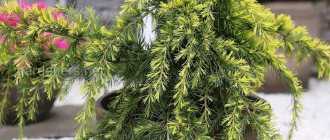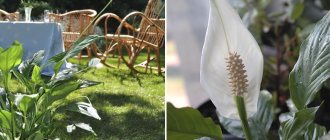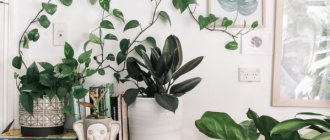If you are more attracted to greenery rather than flowers in indoor plants, feel free to choose reo: this crop blooms really modestly, but its leaves are very beautiful.
True, the concept of “green” can be applied to them with some stretch.
Painted in two primary colors (for example, green on the front side and purple on the back), they are dotted with many stripes of other, additional shades, which makes the plant especially elegant.
Description of features
The rheo flower (in Latin called Rhoeo Hance) belongs to the species “Tradescantia variegated”. Sometimes they write “reo”, it is often called reo tepalata , because its already modest, inconspicuous flowers managed to hide under the leaves-bracts, as if under a blanket.
This botanical feature caused people who studied the plant to associate it with a mythological boat that floated down the Nile, in which lay a baby. It was discovered and saved by an Egyptian princess, and the plant was named reo (by the way, Reo is the name of a forest nymph) and began to be called “Moses’ boat” or “Moses in a basket.”
In its homeland, in the tropical zone, the plant does not know periods of rest. This, however, does not mean that there the reo rolls around like cheese in butter: in dry times, it has to fight for life, using the moisture previously accumulated in the succulent leaves.
At home, this amazing property of the plant helps it stay fresh all year round. And the leaves are truly unique: their length ranges from 25 to 30 cm, width – 5 cm, and thickness – 0.5 cm. Thanks to these parameters, even a single plant, if it is also well-formed, makes a rich, lush bouquet.
Reo variegated (bedspread)
Reo is a perennial crop that is quite easy to care for . In home floriculture, this species is used more often than others. The leaves are dense, shiny, violet-purple on the “underside” and dark green, with longitudinal white stripes on the “front” side.
The flowers (by the way, they can appear at any time of the year) are white and quite spectacular, even despite their miniature size. The “trunk” of the rheo is voluminous enough that, like the “crown,” it contributes to the accumulation of fluid reserves.
The reo palette can also include colors that are unusual for leaves, such as pink or pink (Stripe in Pink variety), burgundy (Compacta).
Reo yellow
Reo yellow is not so often used in indoor floriculture, perhaps because yellow colors create the illusion of fading autumn foliage, and we want fresh, spring colors.
Nevertheless, this type of reo looks very original.
For example, the Vittata variety (as pictured) impresses with its combination of dark purple and intense yellow color.
In the spathacea Vittata variety, the beautiful sandy shade has completely replaced the purple colors.
There are also varieties with a beige color.
Indoor flowers with purple stems
What is the name of an indoor flower with red leaves?
Flowers grown on a windowsill very often have purple “trunks”. There are representatives of home flora that have such original stems:
- Setcreasia purpurea. It belongs to the Tradescantia family, so it requires a lot of attention. It is grown as an ampelous and semi-ampelous plant. It is distinguished not only by completely purple leaves, but also by stems of the same color, as well as lilac small flowers. The shoots are long, growing up to 1 m;
- tradescantia violet. An interesting plant with fleshy purple stems and leaves that accumulate moisture, reaching 20 cm in length. Blooms with small pink flowers. Growth form: semi-ampelous or bushy;
- Columnae Sulfurea is one of the varieties of Columnae (there are about 200 in total), which, like other representatives of this species, has only a hanging variant of growth. Lianas reach up to 1 m in length. All columnae need long daylight hours and bright lighting. These factors ensure their flowering and fruiting. Columnae Sulfurea flowers are tubular and yellow. After flowering, white fruits form on the plant. The stems of this flower are reddish-purple, as is the lower part of the leaf.
Columnea Sulfurea
Purple indoor flowers can decorate any room and bring a little variety to every interior. And it doesn’t matter at all whether it will be painted in this color in whole or in part. The most important thing is effectiveness and unusualness. As a rule, such plants are not too picky, and all they need is as much sunlight as possible to make the color brighter.
Care
Although reo is not a capricious flower, it is very responsive to good care . If you take care of it according to all the rules, reo can become a real decoration for your home flower collection.
Light and temperature
Reo requires good lighting, but direct sunlight can be detrimental to it . The best choice is windows facing west and east.
If you place the reo plant on a southern windowsill, your green pet will need light shading. On northern windows, lighting may be required, because if the flower does not have enough light, its stems will begin to stretch.
ATTENTION : lack of light negatively affects the decorative properties of reo.
This plant should not be exposed to sudden temperature changes . We must try to maintain the air temperature around 20 degrees in summer and at least 15 in winter.
Watering
The amount of watering is adjusted depending on the season:
- from spring to autumn - intense,
- in winter – moderate.
The same approach can be applied to spraying - such water procedures are extremely pleasant for the plant, however, in the cold season they should be carried out less frequently, but not completely eliminated, since due to the operation of heating radiators in the room there is quite low air humidity.
Reo is a moisture-loving crop, so the soil in the pot should always remain moist.
And so that the roots do not suffer from excess moisture, you need to ensure high-quality drainage in advance.
A good option for increasing humidity levels is to place pots on trays filled with wet moss or pebbles.
By regularly adding water to the tray, you will be able to maintain the moisture level required by the plant. The water should be at room temperature and soft in composition. After half an hour or an hour, the water needs to be poured out of the pan.
Fertilizers and fertilizers
Reo needs fertilizers and fertilizing from the first month of spring to August inclusive. They need to be done once every two weeks. In autumn, the number of fertilizing is reduced, in winter - they are stopped completely.
The fact is that in a state of relative dormancy, the plant consumes less nutrients and they begin to accumulate in the soil, which can subsequently have a negative effect on the flower.
It is advisable to use complex mineral fertilizers, as well as organic fertilizers, strictly in accordance with the volumes specified in the instructions.
Experts warn: a plant can more easily tolerate a lack of fertilizer than an excess amount.
Transfer
Adult specimens do not require frequent replanting; it is enough to do it once every 3-4 years . With “youth” this procedure is carried out every spring, usually using the transshipment method. First, the top layer of “old” soil, in which there are no longer any nutrients left, is removed.
Each time the pot is taken a little larger than the previous one , and the shape is always chosen the same - with a large diameter and insignificant depth. The fact is that the rheo root system grows more actively in width than in length. Drainage must be laid at the bottom. For more information about rheo transplantation, watch this video:
House plants decorated with lilac flowers
The large inflorescences of Himalayan geranium look very elegant and mysterious. The color of the flowers is characterized by different shades of purple with streaks of red. The color changes from a delicate lilac tone to a deep lilac. This flower fabulously decorates the interior of any style.
No less interesting are erect indoor flowers 40-50 cm high called Achimenes Ehrenberg, which, when flowering, throws out large beautiful inflorescences of exotic colors. The flowers are purple with a pinkish tint on the outside, and light purple on the inside. The center of the flower is painted with a yellow spotted color. Flowering lasts for several months.
Uzumbara violet (also called Saintpaulia) has all shades of lilac color. These flowers come in different varieties: from simple to double in different shades.
Note! Saintpaulia with simple purple flowers was taken as the basis for breeding activities.
Gloxinia, like other indoor flowers, is not demanding in terms of care, which is why it is liked by gardeners. It has large dark green leaves covered with silvery down. The inflorescences are also large, shaped like bells. All varieties have bright, rich shades of buds with the presence of thick purple tones. The middle is lighter, there is a white border around the edges, and the middle is light in color.
The purple calla lily looks very elegant and majestic. It has an erect trunk with long leaves. Large flowers and leaves resemble wax. The leaves are green with white spots.
Popular houseplant with purple flowers
For your information! It has been noticed that lilac shades give people pleasure, bring peace and tranquility. Mysteries and mysteries, even some mysticism, emanate from lilac indoor flowers, which have characteristic shades not only of leaves and inflorescences, but also of stems, symbolizing the night. Everyone has their own associations.
True flower growers know a lot about cultivating unusual plants in landscape design and use these features when designing garden plots and courtyard areas. As a rule, these unusual flowers only look exotic in appearance, but in fact they require the same care as all other representatives of domestic flora.
Reproduction
Nature itself has come up with a very convenient way of reproduction for rheos - by lateral shoots. In the tropics, this gives the plant the opportunity to easily and quickly expand its habitat.
At the same time, the varietal characteristics of the maternal rheo are completely preserved.
This rule is not violated in the process of home breeding.
However, flower growers like to experiment, which means you can try to increase the “plantations” of reo by sowing seeds.
Seeds
If the plant has received enough solar heat and moisture, the seeds ripen well.
Before planting, they are soaked in water with the addition of a growth-stimulating drug.
A day later they begin planting.
There is no need to press the seeds into the soil; just sprinkle a 2-mm layer of soil on top.
Using a plastic bag, they build a kind of greenhouse and patiently wait (moistening the soil from time to time) for two to six weeks for seedlings to appear.
All this time, it is advisable to maintain the temperature in the room at 20-22 degrees. The “greenhouse” is removed after the formation of two true leaves.
Decorative apple tree
Among fruit trees, it is also worth remembering red-leaved apple trees, which will undoubtedly decorate any area. Even if the fruits of the variety of such a tree you choose do not have an amazing taste, many of them add decorative value to such a crop throughout the season, remaining on the branches not only in late autumn, but sometimes in winter. And during flowering, decorative apple trees present an absolutely incredible sight.
The advantage of ornamental apple trees is their unpretentiousness. You can care for them like regular apple trees. In addition, the trees are winter-hardy and drought-resistant, and you can also choose the variety of the height and crown shape you need.
The best varieties of ornamental apple trees: Weeping (Prirechnaya), Nedzvetsky (Purple), Royalty, Pioneer, Red-leaved red-berry, Paradise, Weeping red-leaved, Profusion.
- Ornamental apple trees - all about planting, care and the best varieties
The blossoms of apple orchards are fascinating, but so fleeting. To prolong the charm, plant ornamental apple trees that are good all year round.
Diseases
If a houseplant does not look entirely healthy, try to understand the reasons and, if possible, eliminate them:
- small leaves - lack of nutrition and light;
- yellow spots – sunburn;
- growth retardation and loss of basal leaves - excess moisture;
- pale colors, thin long stems - lack of light;
- dried, brown tips of the leaves - too much dryness in the room;
- wrinkled leaves - cold or bleached water for irrigation;
- loss of springiness – low room temperatures.
First aid to the victim must be provided, oddly enough, also with water - arrange a warm shower for the patient.
In this way it will be possible to wash away the pests. If the leaves are severely affected, they will have to be removed.
TIP : transplanting rheo into another pot with new soil is effective, while the roots affected by the disease should be cut off.
Annuals
Annuals include plants whose life cycle consists of one period of growth and development.
Angelonia
Angelonia can become a decoration for any garden plot. It can be short, growing up to 30 cm, and quite tall, up to 60 cm.
Unpretentious, can withstand even the highest temperatures even without watering. Resistant to diseases. The plant grows and blooms well both in open ground and in pots.
Brachycome
Brachycome can decorate an alpine hill or become an excellent decoration for border plantings and flower beds. Does not tolerate low temperatures, blooms long and luxuriantly.
Flowering lasts from July to September. If sown early, flowering may begin in June. The bushes formed from the shoots grow up to 25-30 cm.
Nierembergia Caerulea
Nierembergia Caerulea is an ornamental plant. Blooms profusely all summer. Very easy to care for. Does not tolerate low temperatures.
The flowering period lasts from early summer to autumn. The flowers are cup-shaped with a yellow center. The leaves of the plant are pointed. elongated.
Petunia
Petunia is rightfully considered the queen of the garden. It features lush seasonal flowering. It is a bushy plant with large funnel-shaped flowers. Grows well in pots, on balconies, terraces and in the garden.
Purple petunia flowers come in different shades. They look very beautiful, they come in different varieties and shapes (photos with names show the variety of petunia varieties).
| N p/p | Types and varieties | Forms | Peculiarities | Variety name |
| 1. | Hybrid | Multiflora | Unpretentiousness, splendor of flowering. | Alderman |
| Large-flowered | Capriciousness and beauty of flowering, flower diameter up to 15 cm. | Triumph, Pikoti. | ||
| Floribunda | Abundant flowering, unpretentiousness, large flowers. | It is a hybrid of multi-flowered and large-flowered. | ||
| 2. | Ampelnaya | Long shoots thermophilicity, moisture-loving, grows downwards. | Wave, Avalanche, Opera Supreme. | |
| 3. | Cascade | It grows first upward, and then the branches fall down; shoots are thick and short. | Mona Lisa, Tornado, Burgundy, Surfinia. |
The benefits and harms of the reo flower
Rarely does anyone consider reo as a home healer, but traditional medicine recommends using the plant:
- for rheumatism (in the form of compresses);
- wounds on the skin (the leaf must be crushed, placed on the problem area and bandaged);
- for intestinal diseases (consume orally a decoction that has been prepared for 20 minutes).
CAUTION : some people may be allergic to the plant sap - if it gets on the skin (during pruning leaves, pinching), it can cause redness and irritation.
The indoor flower reo also has a number of useful mystical properties: endowing a person with creative energy, determination, and neutralizing aggression. Popular signs and superstitions say that this flower protects its owners from witchcraft and protects against love spells.
Unfortunately, if a person has taken poor care of the green pet itself and the plant gets sick, then it begins to emit negative energy into the atmosphere of the room, and therefore unwittingly harm people.
Reo
Reo is a powerful plant with long narrow leaves, dark green on top with pale stripes, and deep purple below.
Since reo is a close relative of zebrina and tradescantia, its care is similar . In favorable conditions, the plant quickly grows into a bush of any shape.
Reo flower
In 1-2 years, reo can fill a wide pot or flowerpot with rhizome shoots. Propagated by cuttings, young shoots or seeds.
This unusual purple tulip
Tulips continue the purple wave of flowering, in particular varieties such as Traveler, with its beautiful rich purple hue, Chanson, characterized by dark blue-violet goblet flowers edged with a contrasting white border. The “Alibi” variety, characterized by a light purple color and the dark violet, almost black with a white edging, “Jackpot”. The lily-purple flower “Burgundy” and the purple variety “Ballad” with a white border will stand out for their original color in a well-arranged flower arrangement. "Porple Dream" diversifies this purple collage by adding a red tint.
Decorative onions bloom with purple flowers, various varieties of which can be used as a worthy decoration for any flower bed. These are Aflatun onion, Karatav onion, giant onion, Christoph onion.
Crocuses - the purple charm of spring
Beautiful crocuses, whose goblet-shaped flowers “scream” about the arrival of the long-awaited spring, will speed up the passing of winter with splashes of purple paint against the background of melting snow. Reproduction of such beauty is not particularly difficult and consists of separating the children from the mother plant, which in a year will delight with the first flowering. To create an original composition, purple flowers are recommended, the names of which are given below:
- Nigro Boy - with dark purple flowers, purple at the base and having a barely noticeable light border along the edges of the petals.
- Paulus Potter - flowers are dark purple with a reddish tint.
- Purpureus grandiflorus - blooms with purple flowers, large (about 5 cm), dark at the base.
- Snowstor - white flowers with bright purple stripes at the base.
- Remebrance is a purple flower with a dark base and a characteristic silvery sheen.
- Flower Record - purple flowers with oval, elongated petals and characteristic pointed tips.
- Crocus Geufel is one of the largest species. The size of the purple flowers is about 7 cm.
You can dilute a monogamous landscape with the colors of the sun using the Violet Queen variety, whose yellow-violet flowers will add freshness, brightness and contrast to the composition.
Hyacinth is an indispensable component of the purple palette
When it comes to flowers that add a splash of color to garden beds, it is worth mentioning purple flowers, whose names translated from Greek mean “flowers of rain.” These are hyacinths. Strong, luxurious, dense inflorescences captivate with their pleasant aroma, delicate beauty and rich color palette, in which purple is effectively represented.
These are varieties such as “Blue Jacket” and “Ostara”, which have a blue-violet color; “Peter Stuycent” is characterized by a blue-lilac hue; "Woodstock" and "Maria" are dark purple varieties, "Bismarck" is a light purple flower, and "Miss Saigon" is a purple-red flower.
